BSBLDR502 Project: Lead and Manage Effective Workplace Relationships
VerifiedAdded on 2023/04/17
|23
|4389
|253
Project
AI Summary
This project provides a comprehensive analysis of leading and managing effective workplace relationships. It includes the development of a code of conduct, workplace communication and consultation policies, and dispute resolution procedures. The project also explores the importance of networking and provides a networking plan. Furthermore, it addresses managing workplace difficulties through meeting preparation, conflict resolution, and follow-up actions. The document outlines key steps for identifying and resolving workplace problems, effective conflict resolution techniques, and the benefits of diversity policies. This resource is available on Desklib, where students can find a wealth of solved assignments and past papers.
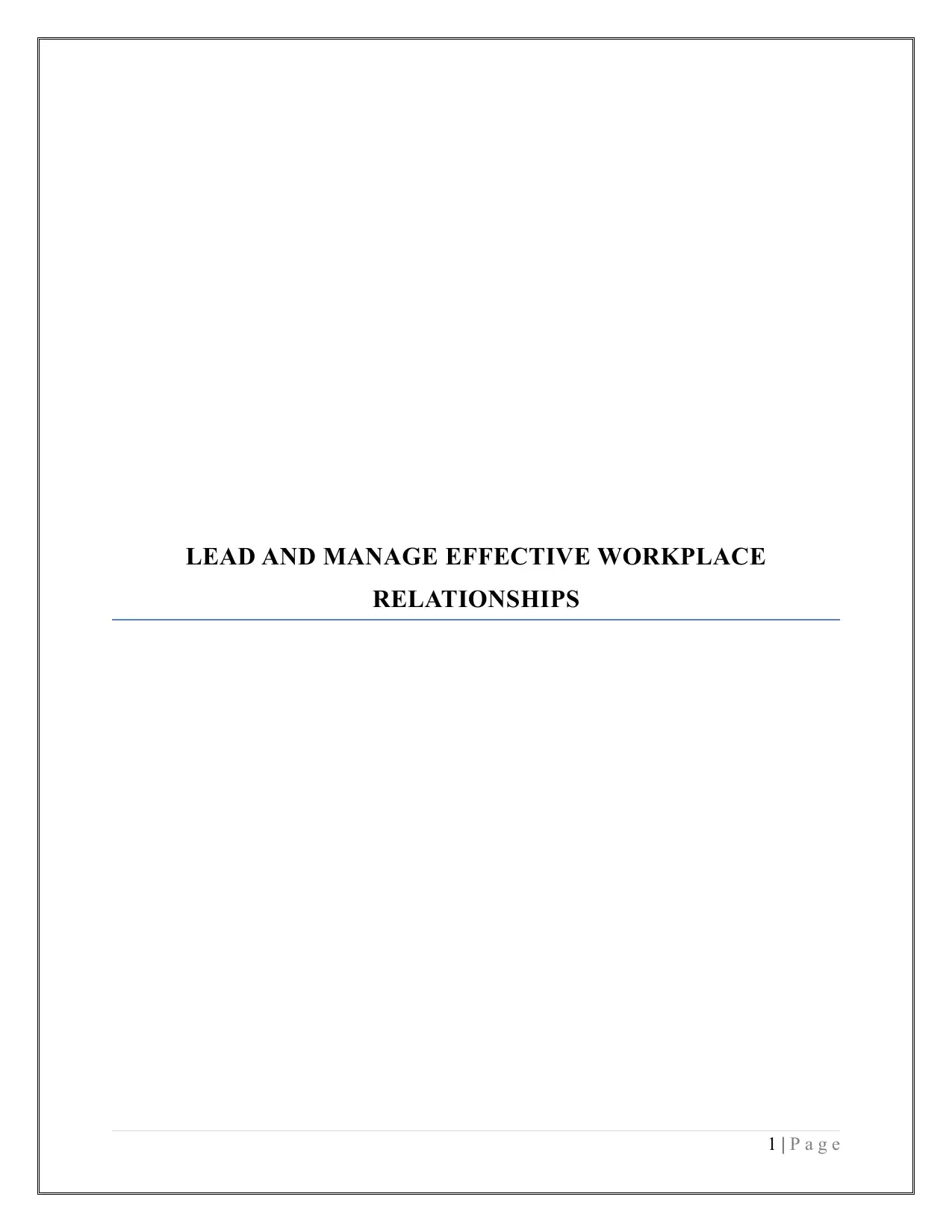
LEAD AND MANAGE EFFECTIVE WORKPLACE
RELATIONSHIPS
1 | P a g e
RELATIONSHIPS
1 | P a g e
Paraphrase This Document
Need a fresh take? Get an instant paraphrase of this document with our AI Paraphraser
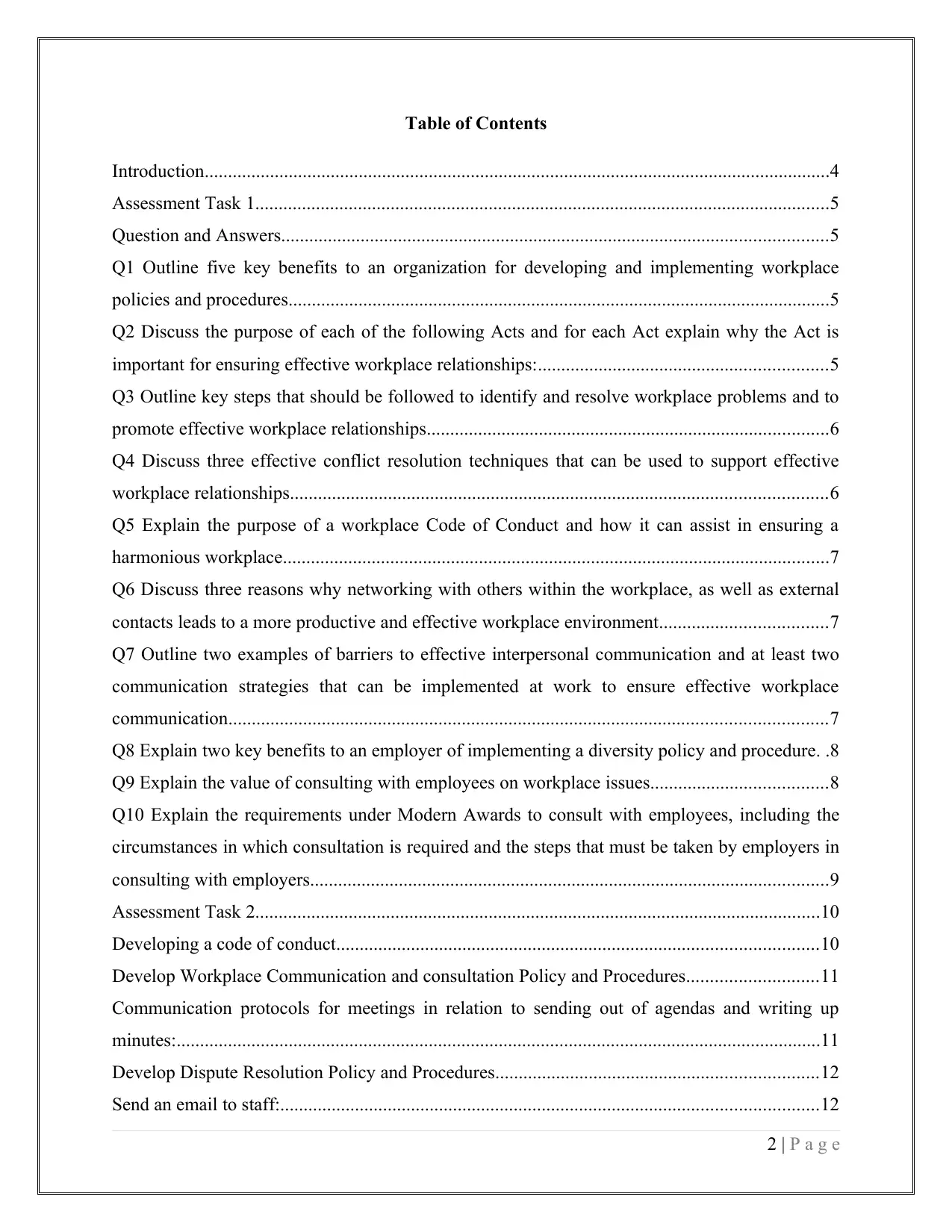
Table of Contents
Introduction......................................................................................................................................4
Assessment Task 1...........................................................................................................................5
Question and Answers.....................................................................................................................5
Q1 Outline five key benefits to an organization for developing and implementing workplace
policies and procedures....................................................................................................................5
Q2 Discuss the purpose of each of the following Acts and for each Act explain why the Act is
important for ensuring effective workplace relationships:..............................................................5
Q3 Outline key steps that should be followed to identify and resolve workplace problems and to
promote effective workplace relationships......................................................................................6
Q4 Discuss three effective conflict resolution techniques that can be used to support effective
workplace relationships...................................................................................................................6
Q5 Explain the purpose of a workplace Code of Conduct and how it can assist in ensuring a
harmonious workplace.....................................................................................................................7
Q6 Discuss three reasons why networking with others within the workplace, as well as external
contacts leads to a more productive and effective workplace environment....................................7
Q7 Outline two examples of barriers to effective interpersonal communication and at least two
communication strategies that can be implemented at work to ensure effective workplace
communication................................................................................................................................7
Q8 Explain two key benefits to an employer of implementing a diversity policy and procedure. .8
Q9 Explain the value of consulting with employees on workplace issues......................................8
Q10 Explain the requirements under Modern Awards to consult with employees, including the
circumstances in which consultation is required and the steps that must be taken by employers in
consulting with employers...............................................................................................................9
Assessment Task 2.........................................................................................................................10
Developing a code of conduct.......................................................................................................10
Develop Workplace Communication and consultation Policy and Procedures............................11
Communication protocols for meetings in relation to sending out of agendas and writing up
minutes:..........................................................................................................................................11
Develop Dispute Resolution Policy and Procedures.....................................................................12
Send an email to staff:...................................................................................................................12
2 | P a g e
Introduction......................................................................................................................................4
Assessment Task 1...........................................................................................................................5
Question and Answers.....................................................................................................................5
Q1 Outline five key benefits to an organization for developing and implementing workplace
policies and procedures....................................................................................................................5
Q2 Discuss the purpose of each of the following Acts and for each Act explain why the Act is
important for ensuring effective workplace relationships:..............................................................5
Q3 Outline key steps that should be followed to identify and resolve workplace problems and to
promote effective workplace relationships......................................................................................6
Q4 Discuss three effective conflict resolution techniques that can be used to support effective
workplace relationships...................................................................................................................6
Q5 Explain the purpose of a workplace Code of Conduct and how it can assist in ensuring a
harmonious workplace.....................................................................................................................7
Q6 Discuss three reasons why networking with others within the workplace, as well as external
contacts leads to a more productive and effective workplace environment....................................7
Q7 Outline two examples of barriers to effective interpersonal communication and at least two
communication strategies that can be implemented at work to ensure effective workplace
communication................................................................................................................................7
Q8 Explain two key benefits to an employer of implementing a diversity policy and procedure. .8
Q9 Explain the value of consulting with employees on workplace issues......................................8
Q10 Explain the requirements under Modern Awards to consult with employees, including the
circumstances in which consultation is required and the steps that must be taken by employers in
consulting with employers...............................................................................................................9
Assessment Task 2.........................................................................................................................10
Developing a code of conduct.......................................................................................................10
Develop Workplace Communication and consultation Policy and Procedures............................11
Communication protocols for meetings in relation to sending out of agendas and writing up
minutes:..........................................................................................................................................11
Develop Dispute Resolution Policy and Procedures.....................................................................12
Send an email to staff:...................................................................................................................12
2 | P a g e
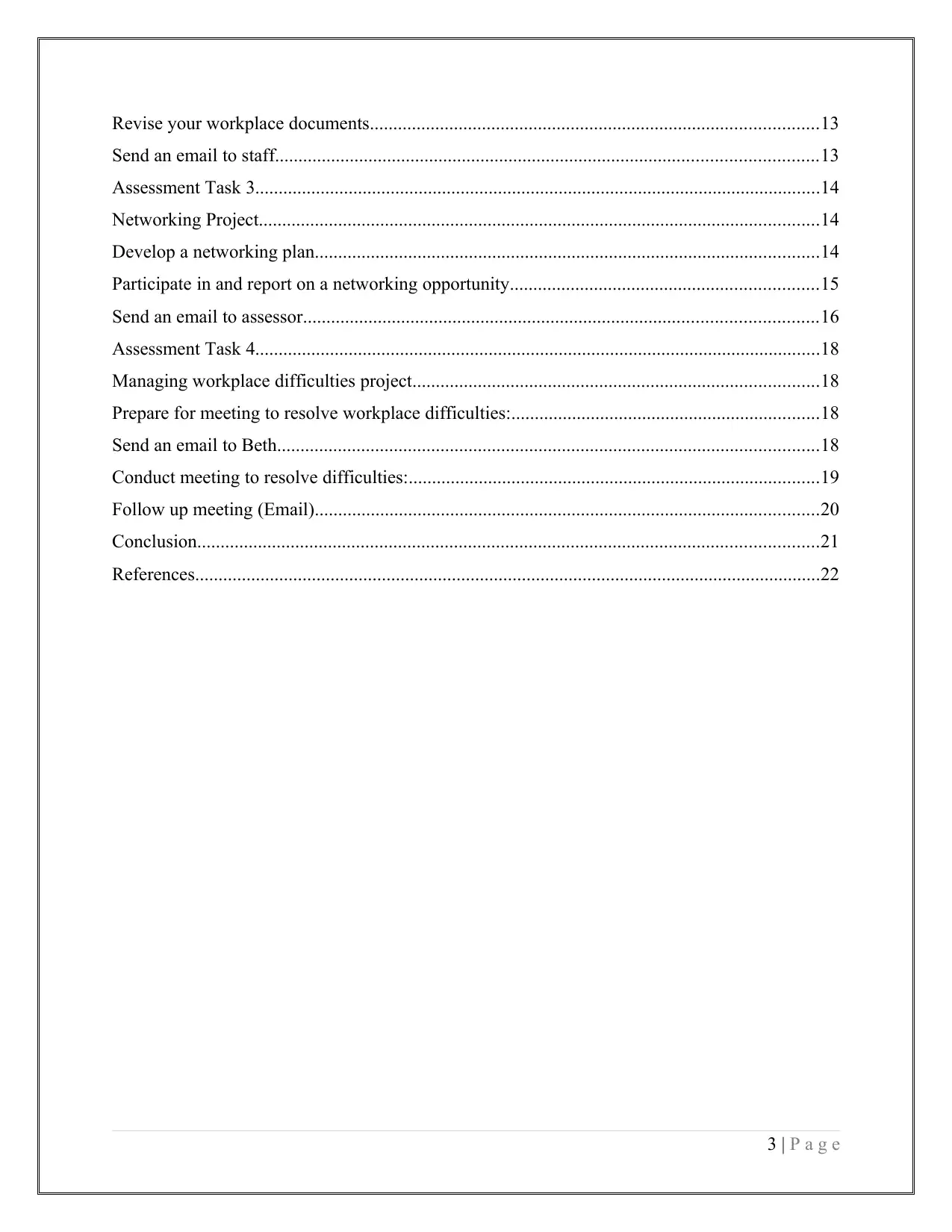
Revise your workplace documents................................................................................................13
Send an email to staff....................................................................................................................13
Assessment Task 3.........................................................................................................................14
Networking Project........................................................................................................................14
Develop a networking plan............................................................................................................14
Participate in and report on a networking opportunity..................................................................15
Send an email to assessor..............................................................................................................16
Assessment Task 4.........................................................................................................................18
Managing workplace difficulties project.......................................................................................18
Prepare for meeting to resolve workplace difficulties:..................................................................18
Send an email to Beth....................................................................................................................18
Conduct meeting to resolve difficulties:........................................................................................19
Follow up meeting (Email)............................................................................................................20
Conclusion.....................................................................................................................................21
References......................................................................................................................................22
3 | P a g e
Send an email to staff....................................................................................................................13
Assessment Task 3.........................................................................................................................14
Networking Project........................................................................................................................14
Develop a networking plan............................................................................................................14
Participate in and report on a networking opportunity..................................................................15
Send an email to assessor..............................................................................................................16
Assessment Task 4.........................................................................................................................18
Managing workplace difficulties project.......................................................................................18
Prepare for meeting to resolve workplace difficulties:..................................................................18
Send an email to Beth....................................................................................................................18
Conduct meeting to resolve difficulties:........................................................................................19
Follow up meeting (Email)............................................................................................................20
Conclusion.....................................................................................................................................21
References......................................................................................................................................22
3 | P a g e
⊘ This is a preview!⊘
Do you want full access?
Subscribe today to unlock all pages.

Trusted by 1+ million students worldwide
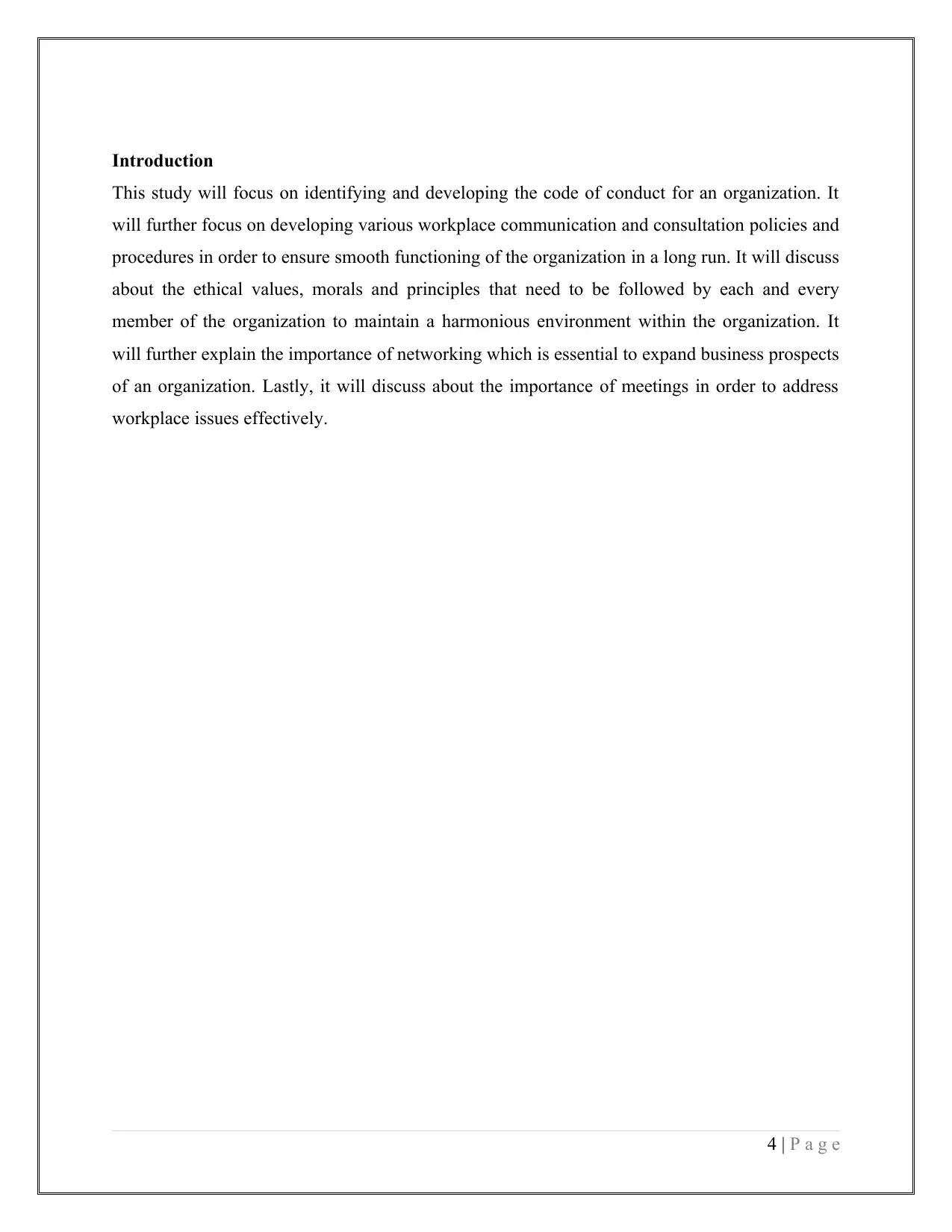
Introduction
This study will focus on identifying and developing the code of conduct for an organization. It
will further focus on developing various workplace communication and consultation policies and
procedures in order to ensure smooth functioning of the organization in a long run. It will discuss
about the ethical values, morals and principles that need to be followed by each and every
member of the organization to maintain a harmonious environment within the organization. It
will further explain the importance of networking which is essential to expand business prospects
of an organization. Lastly, it will discuss about the importance of meetings in order to address
workplace issues effectively.
4 | P a g e
This study will focus on identifying and developing the code of conduct for an organization. It
will further focus on developing various workplace communication and consultation policies and
procedures in order to ensure smooth functioning of the organization in a long run. It will discuss
about the ethical values, morals and principles that need to be followed by each and every
member of the organization to maintain a harmonious environment within the organization. It
will further explain the importance of networking which is essential to expand business prospects
of an organization. Lastly, it will discuss about the importance of meetings in order to address
workplace issues effectively.
4 | P a g e
Paraphrase This Document
Need a fresh take? Get an instant paraphrase of this document with our AI Paraphraser
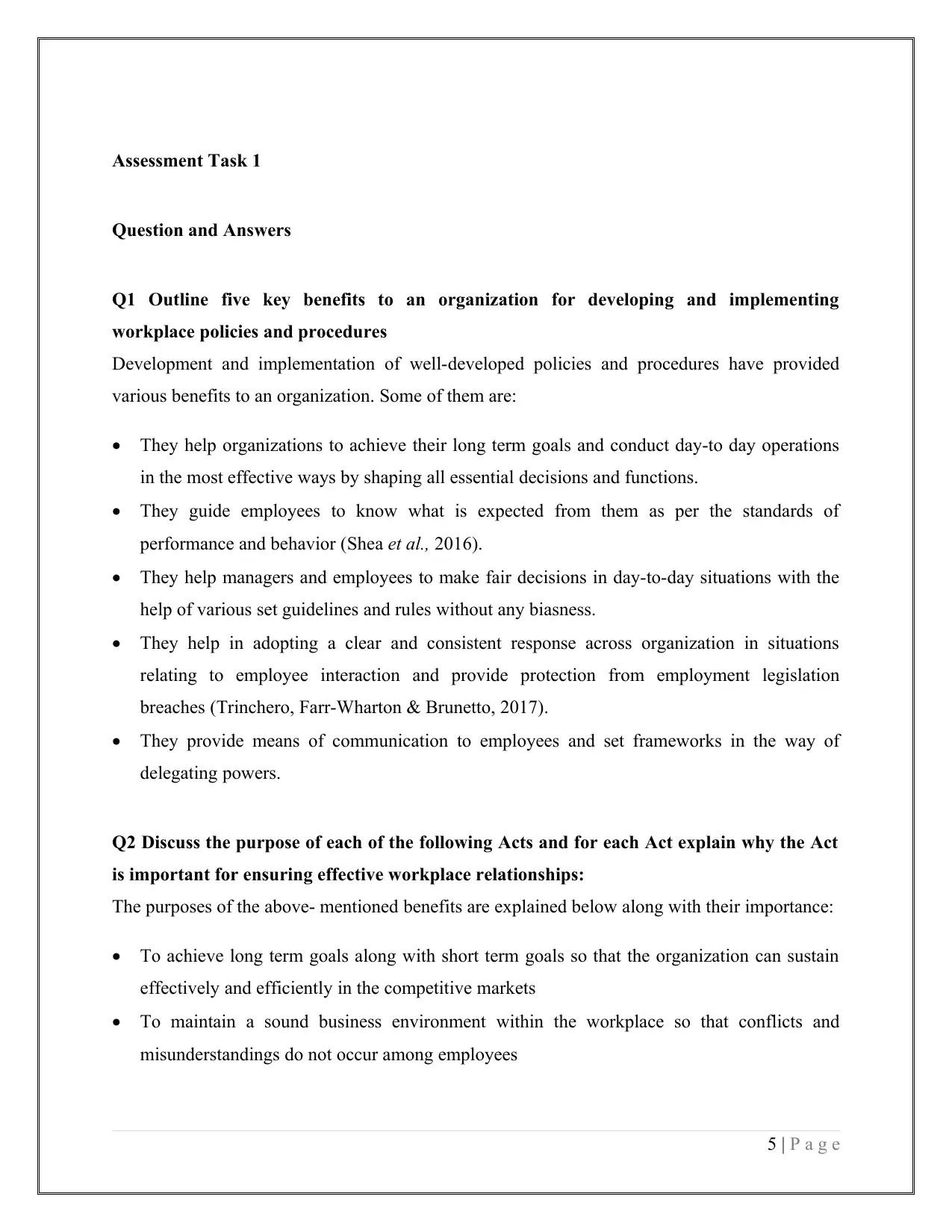
Assessment Task 1
Question and Answers
Q1 Outline five key benefits to an organization for developing and implementing
workplace policies and procedures
Development and implementation of well-developed policies and procedures have provided
various benefits to an organization. Some of them are:
They help organizations to achieve their long term goals and conduct day-to day operations
in the most effective ways by shaping all essential decisions and functions.
They guide employees to know what is expected from them as per the standards of
performance and behavior (Shea et al., 2016).
They help managers and employees to make fair decisions in day-to-day situations with the
help of various set guidelines and rules without any biasness.
They help in adopting a clear and consistent response across organization in situations
relating to employee interaction and provide protection from employment legislation
breaches (Trinchero, Farr-Wharton & Brunetto, 2017).
They provide means of communication to employees and set frameworks in the way of
delegating powers.
Q2 Discuss the purpose of each of the following Acts and for each Act explain why the Act
is important for ensuring effective workplace relationships:
The purposes of the above- mentioned benefits are explained below along with their importance:
To achieve long term goals along with short term goals so that the organization can sustain
effectively and efficiently in the competitive markets
To maintain a sound business environment within the workplace so that conflicts and
misunderstandings do not occur among employees
5 | P a g e
Question and Answers
Q1 Outline five key benefits to an organization for developing and implementing
workplace policies and procedures
Development and implementation of well-developed policies and procedures have provided
various benefits to an organization. Some of them are:
They help organizations to achieve their long term goals and conduct day-to day operations
in the most effective ways by shaping all essential decisions and functions.
They guide employees to know what is expected from them as per the standards of
performance and behavior (Shea et al., 2016).
They help managers and employees to make fair decisions in day-to-day situations with the
help of various set guidelines and rules without any biasness.
They help in adopting a clear and consistent response across organization in situations
relating to employee interaction and provide protection from employment legislation
breaches (Trinchero, Farr-Wharton & Brunetto, 2017).
They provide means of communication to employees and set frameworks in the way of
delegating powers.
Q2 Discuss the purpose of each of the following Acts and for each Act explain why the Act
is important for ensuring effective workplace relationships:
The purposes of the above- mentioned benefits are explained below along with their importance:
To achieve long term goals along with short term goals so that the organization can sustain
effectively and efficiently in the competitive markets
To maintain a sound business environment within the workplace so that conflicts and
misunderstandings do not occur among employees
5 | P a g e
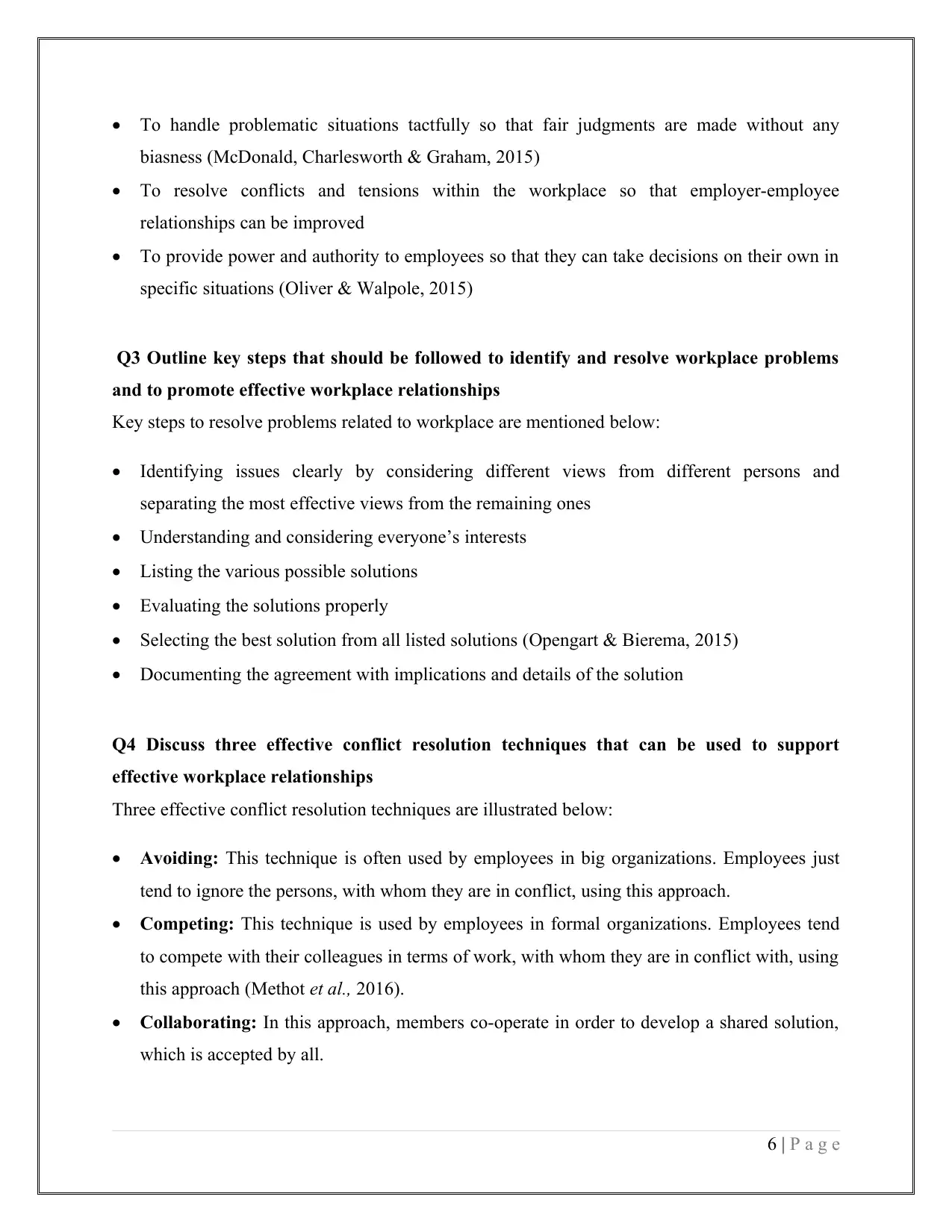
To handle problematic situations tactfully so that fair judgments are made without any
biasness (McDonald, Charlesworth & Graham, 2015)
To resolve conflicts and tensions within the workplace so that employer-employee
relationships can be improved
To provide power and authority to employees so that they can take decisions on their own in
specific situations (Oliver & Walpole, 2015)
Q3 Outline key steps that should be followed to identify and resolve workplace problems
and to promote effective workplace relationships
Key steps to resolve problems related to workplace are mentioned below:
Identifying issues clearly by considering different views from different persons and
separating the most effective views from the remaining ones
Understanding and considering everyone’s interests
Listing the various possible solutions
Evaluating the solutions properly
Selecting the best solution from all listed solutions (Opengart & Bierema, 2015)
Documenting the agreement with implications and details of the solution
Q4 Discuss three effective conflict resolution techniques that can be used to support
effective workplace relationships
Three effective conflict resolution techniques are illustrated below:
Avoiding: This technique is often used by employees in big organizations. Employees just
tend to ignore the persons, with whom they are in conflict, using this approach.
Competing: This technique is used by employees in formal organizations. Employees tend
to compete with their colleagues in terms of work, with whom they are in conflict with, using
this approach (Methot et al., 2016).
Collaborating: In this approach, members co-operate in order to develop a shared solution,
which is accepted by all.
6 | P a g e
biasness (McDonald, Charlesworth & Graham, 2015)
To resolve conflicts and tensions within the workplace so that employer-employee
relationships can be improved
To provide power and authority to employees so that they can take decisions on their own in
specific situations (Oliver & Walpole, 2015)
Q3 Outline key steps that should be followed to identify and resolve workplace problems
and to promote effective workplace relationships
Key steps to resolve problems related to workplace are mentioned below:
Identifying issues clearly by considering different views from different persons and
separating the most effective views from the remaining ones
Understanding and considering everyone’s interests
Listing the various possible solutions
Evaluating the solutions properly
Selecting the best solution from all listed solutions (Opengart & Bierema, 2015)
Documenting the agreement with implications and details of the solution
Q4 Discuss three effective conflict resolution techniques that can be used to support
effective workplace relationships
Three effective conflict resolution techniques are illustrated below:
Avoiding: This technique is often used by employees in big organizations. Employees just
tend to ignore the persons, with whom they are in conflict, using this approach.
Competing: This technique is used by employees in formal organizations. Employees tend
to compete with their colleagues in terms of work, with whom they are in conflict with, using
this approach (Methot et al., 2016).
Collaborating: In this approach, members co-operate in order to develop a shared solution,
which is accepted by all.
6 | P a g e
⊘ This is a preview!⊘
Do you want full access?
Subscribe today to unlock all pages.

Trusted by 1+ million students worldwide
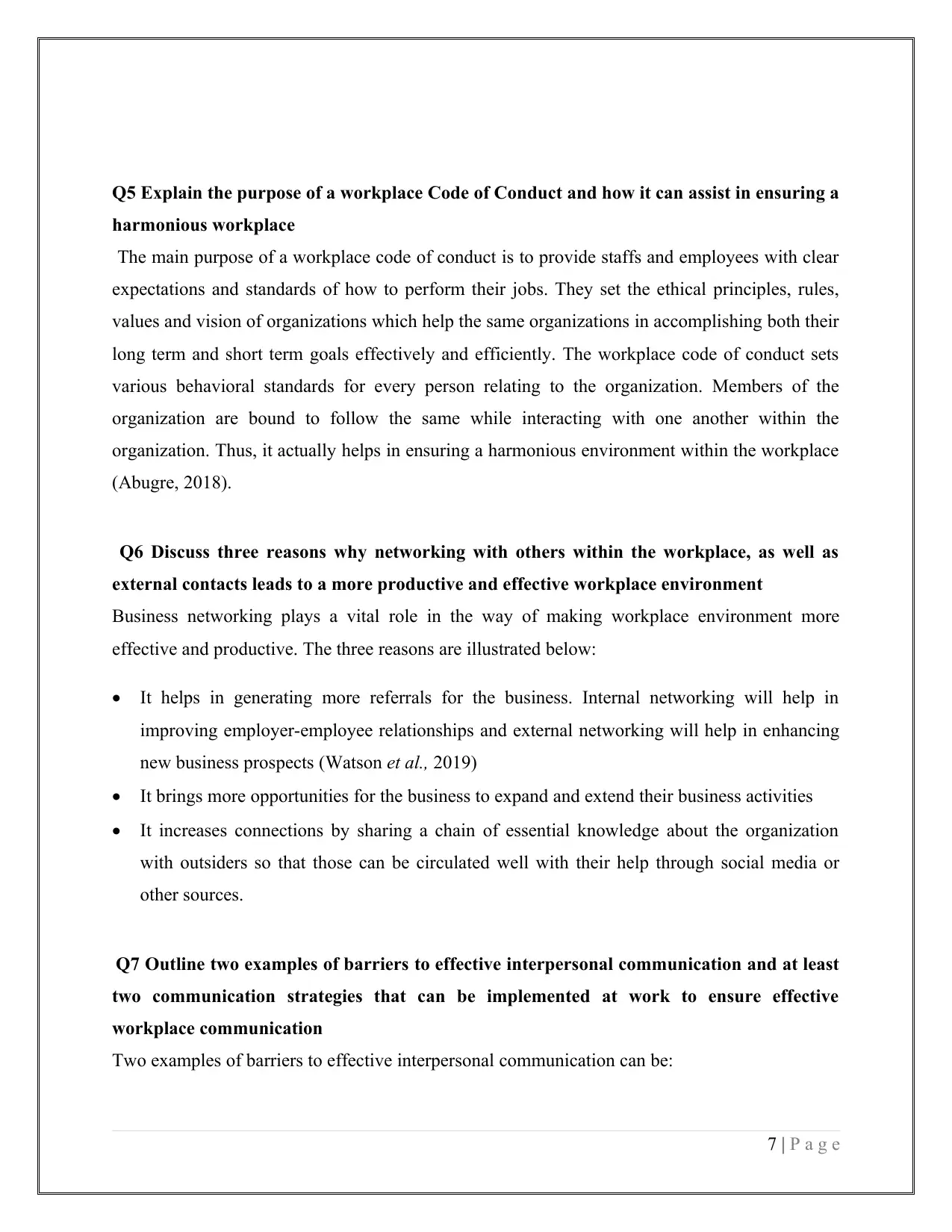
Q5 Explain the purpose of a workplace Code of Conduct and how it can assist in ensuring a
harmonious workplace
The main purpose of a workplace code of conduct is to provide staffs and employees with clear
expectations and standards of how to perform their jobs. They set the ethical principles, rules,
values and vision of organizations which help the same organizations in accomplishing both their
long term and short term goals effectively and efficiently. The workplace code of conduct sets
various behavioral standards for every person relating to the organization. Members of the
organization are bound to follow the same while interacting with one another within the
organization. Thus, it actually helps in ensuring a harmonious environment within the workplace
(Abugre, 2018).
Q6 Discuss three reasons why networking with others within the workplace, as well as
external contacts leads to a more productive and effective workplace environment
Business networking plays a vital role in the way of making workplace environment more
effective and productive. The three reasons are illustrated below:
It helps in generating more referrals for the business. Internal networking will help in
improving employer-employee relationships and external networking will help in enhancing
new business prospects (Watson et al., 2019)
It brings more opportunities for the business to expand and extend their business activities
It increases connections by sharing a chain of essential knowledge about the organization
with outsiders so that those can be circulated well with their help through social media or
other sources.
Q7 Outline two examples of barriers to effective interpersonal communication and at least
two communication strategies that can be implemented at work to ensure effective
workplace communication
Two examples of barriers to effective interpersonal communication can be:
7 | P a g e
harmonious workplace
The main purpose of a workplace code of conduct is to provide staffs and employees with clear
expectations and standards of how to perform their jobs. They set the ethical principles, rules,
values and vision of organizations which help the same organizations in accomplishing both their
long term and short term goals effectively and efficiently. The workplace code of conduct sets
various behavioral standards for every person relating to the organization. Members of the
organization are bound to follow the same while interacting with one another within the
organization. Thus, it actually helps in ensuring a harmonious environment within the workplace
(Abugre, 2018).
Q6 Discuss three reasons why networking with others within the workplace, as well as
external contacts leads to a more productive and effective workplace environment
Business networking plays a vital role in the way of making workplace environment more
effective and productive. The three reasons are illustrated below:
It helps in generating more referrals for the business. Internal networking will help in
improving employer-employee relationships and external networking will help in enhancing
new business prospects (Watson et al., 2019)
It brings more opportunities for the business to expand and extend their business activities
It increases connections by sharing a chain of essential knowledge about the organization
with outsiders so that those can be circulated well with their help through social media or
other sources.
Q7 Outline two examples of barriers to effective interpersonal communication and at least
two communication strategies that can be implemented at work to ensure effective
workplace communication
Two examples of barriers to effective interpersonal communication can be:
7 | P a g e
Paraphrase This Document
Need a fresh take? Get an instant paraphrase of this document with our AI Paraphraser
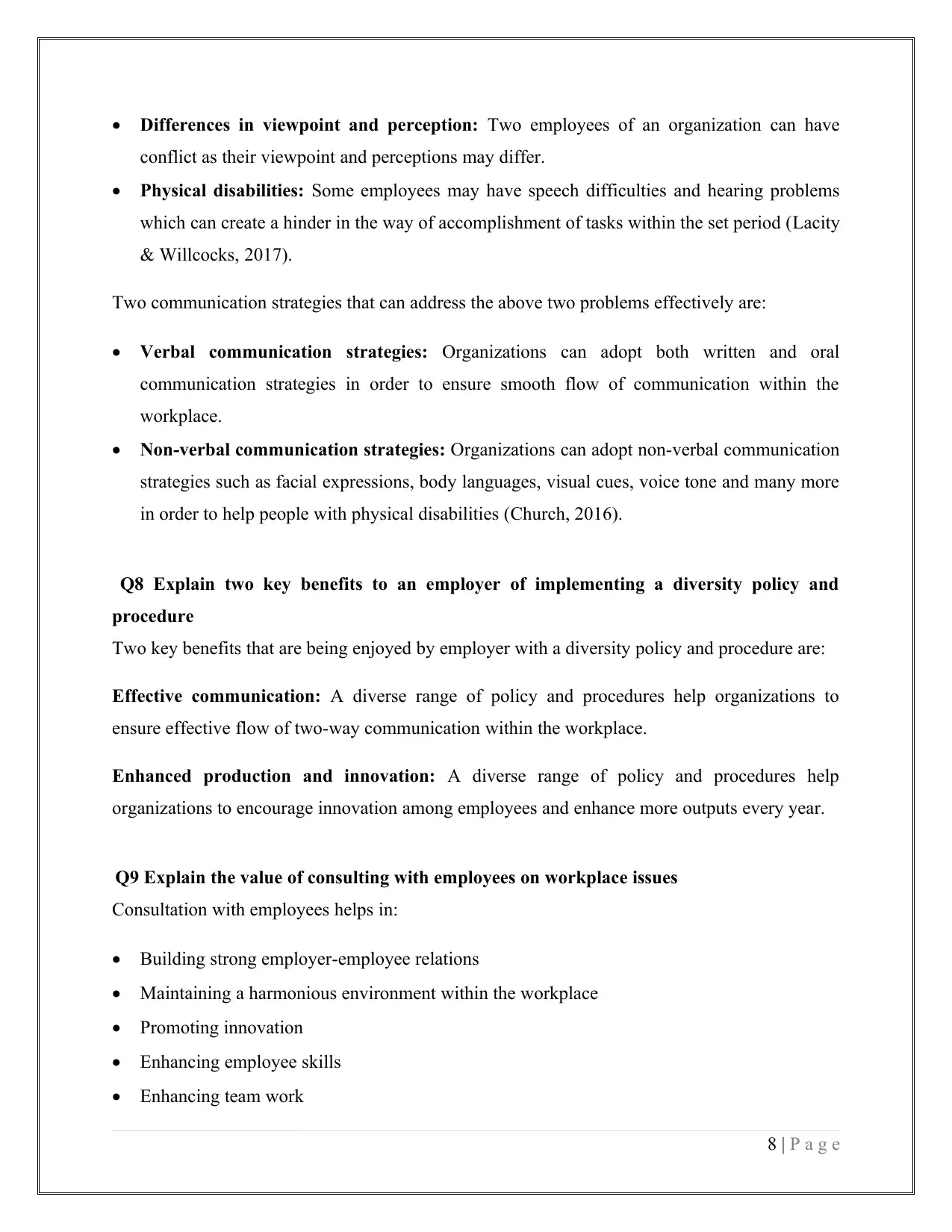
Differences in viewpoint and perception: Two employees of an organization can have
conflict as their viewpoint and perceptions may differ.
Physical disabilities: Some employees may have speech difficulties and hearing problems
which can create a hinder in the way of accomplishment of tasks within the set period (Lacity
& Willcocks, 2017).
Two communication strategies that can address the above two problems effectively are:
Verbal communication strategies: Organizations can adopt both written and oral
communication strategies in order to ensure smooth flow of communication within the
workplace.
Non-verbal communication strategies: Organizations can adopt non-verbal communication
strategies such as facial expressions, body languages, visual cues, voice tone and many more
in order to help people with physical disabilities (Church, 2016).
Q8 Explain two key benefits to an employer of implementing a diversity policy and
procedure
Two key benefits that are being enjoyed by employer with a diversity policy and procedure are:
Effective communication: A diverse range of policy and procedures help organizations to
ensure effective flow of two-way communication within the workplace.
Enhanced production and innovation: A diverse range of policy and procedures help
organizations to encourage innovation among employees and enhance more outputs every year.
Q9 Explain the value of consulting with employees on workplace issues
Consultation with employees helps in:
Building strong employer-employee relations
Maintaining a harmonious environment within the workplace
Promoting innovation
Enhancing employee skills
Enhancing team work
8 | P a g e
conflict as their viewpoint and perceptions may differ.
Physical disabilities: Some employees may have speech difficulties and hearing problems
which can create a hinder in the way of accomplishment of tasks within the set period (Lacity
& Willcocks, 2017).
Two communication strategies that can address the above two problems effectively are:
Verbal communication strategies: Organizations can adopt both written and oral
communication strategies in order to ensure smooth flow of communication within the
workplace.
Non-verbal communication strategies: Organizations can adopt non-verbal communication
strategies such as facial expressions, body languages, visual cues, voice tone and many more
in order to help people with physical disabilities (Church, 2016).
Q8 Explain two key benefits to an employer of implementing a diversity policy and
procedure
Two key benefits that are being enjoyed by employer with a diversity policy and procedure are:
Effective communication: A diverse range of policy and procedures help organizations to
ensure effective flow of two-way communication within the workplace.
Enhanced production and innovation: A diverse range of policy and procedures help
organizations to encourage innovation among employees and enhance more outputs every year.
Q9 Explain the value of consulting with employees on workplace issues
Consultation with employees helps in:
Building strong employer-employee relations
Maintaining a harmonious environment within the workplace
Promoting innovation
Enhancing employee skills
Enhancing team work
8 | P a g e
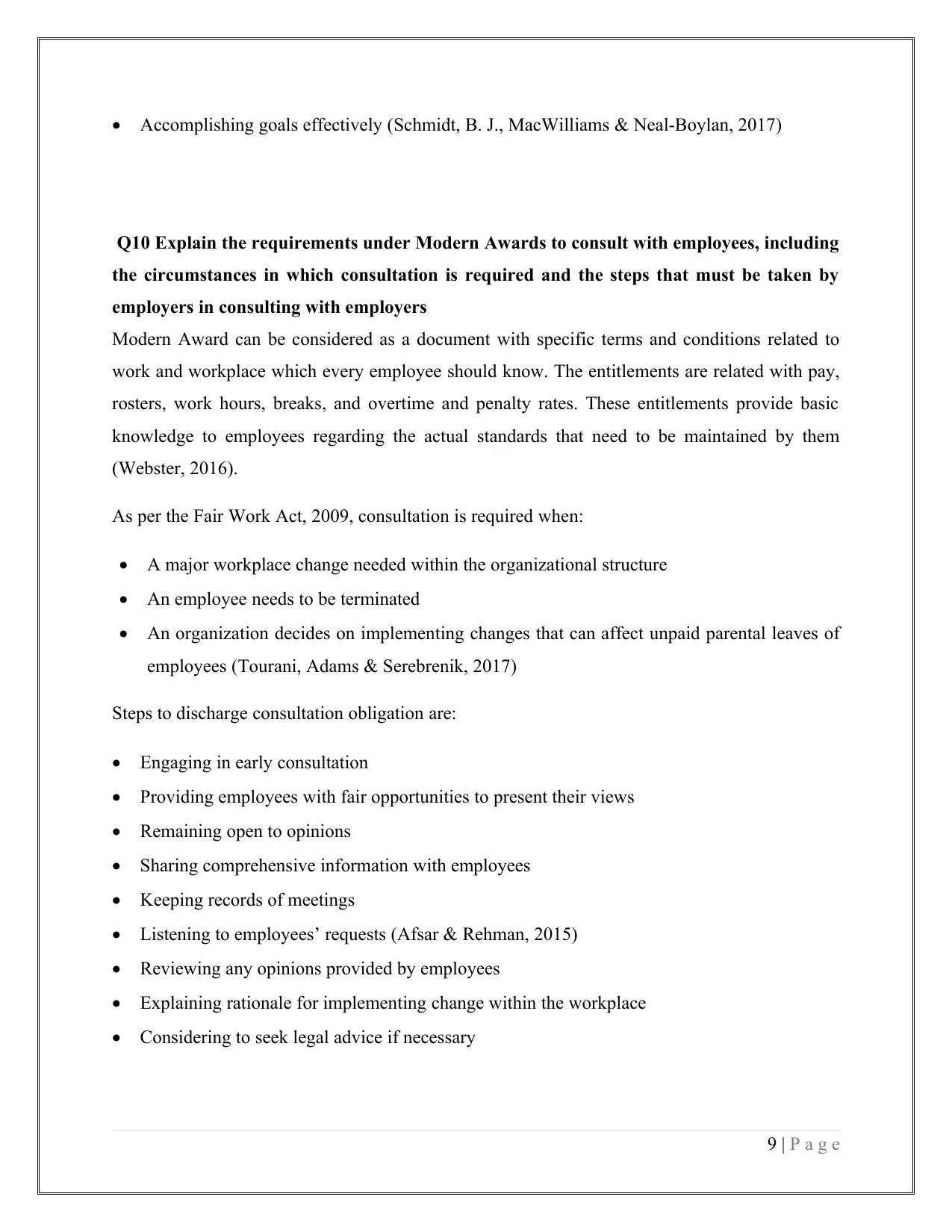
Accomplishing goals effectively (Schmidt, B. J., MacWilliams & Neal-Boylan, 2017)
Q10 Explain the requirements under Modern Awards to consult with employees, including
the circumstances in which consultation is required and the steps that must be taken by
employers in consulting with employers
Modern Award can be considered as a document with specific terms and conditions related to
work and workplace which every employee should know. The entitlements are related with pay,
rosters, work hours, breaks, and overtime and penalty rates. These entitlements provide basic
knowledge to employees regarding the actual standards that need to be maintained by them
(Webster, 2016).
As per the Fair Work Act, 2009, consultation is required when:
A major workplace change needed within the organizational structure
An employee needs to be terminated
An organization decides on implementing changes that can affect unpaid parental leaves of
employees (Tourani, Adams & Serebrenik, 2017)
Steps to discharge consultation obligation are:
Engaging in early consultation
Providing employees with fair opportunities to present their views
Remaining open to opinions
Sharing comprehensive information with employees
Keeping records of meetings
Listening to employees’ requests (Afsar & Rehman, 2015)
Reviewing any opinions provided by employees
Explaining rationale for implementing change within the workplace
Considering to seek legal advice if necessary
9 | P a g e
Q10 Explain the requirements under Modern Awards to consult with employees, including
the circumstances in which consultation is required and the steps that must be taken by
employers in consulting with employers
Modern Award can be considered as a document with specific terms and conditions related to
work and workplace which every employee should know. The entitlements are related with pay,
rosters, work hours, breaks, and overtime and penalty rates. These entitlements provide basic
knowledge to employees regarding the actual standards that need to be maintained by them
(Webster, 2016).
As per the Fair Work Act, 2009, consultation is required when:
A major workplace change needed within the organizational structure
An employee needs to be terminated
An organization decides on implementing changes that can affect unpaid parental leaves of
employees (Tourani, Adams & Serebrenik, 2017)
Steps to discharge consultation obligation are:
Engaging in early consultation
Providing employees with fair opportunities to present their views
Remaining open to opinions
Sharing comprehensive information with employees
Keeping records of meetings
Listening to employees’ requests (Afsar & Rehman, 2015)
Reviewing any opinions provided by employees
Explaining rationale for implementing change within the workplace
Considering to seek legal advice if necessary
9 | P a g e
⊘ This is a preview!⊘
Do you want full access?
Subscribe today to unlock all pages.

Trusted by 1+ million students worldwide
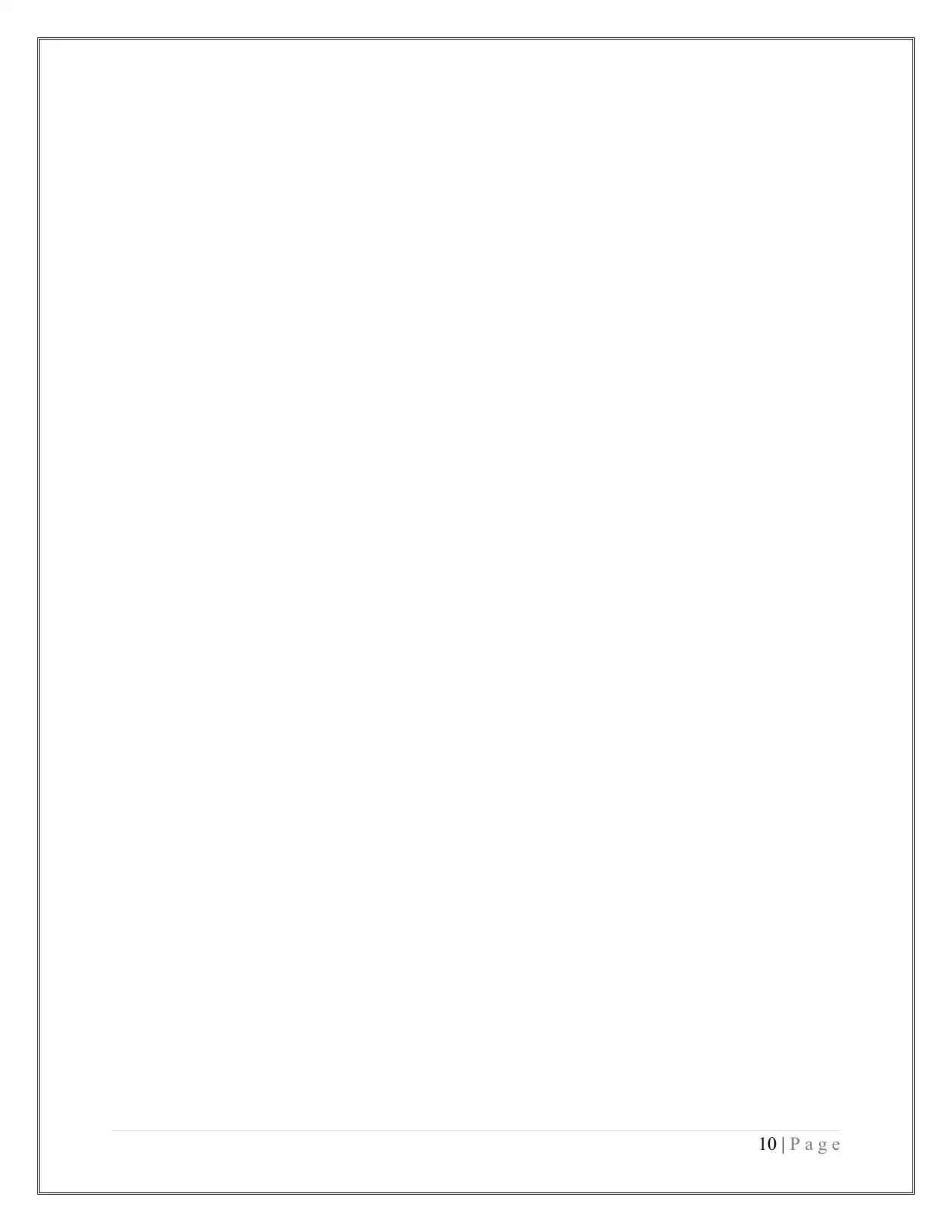
10 | P a g e
Paraphrase This Document
Need a fresh take? Get an instant paraphrase of this document with our AI Paraphraser
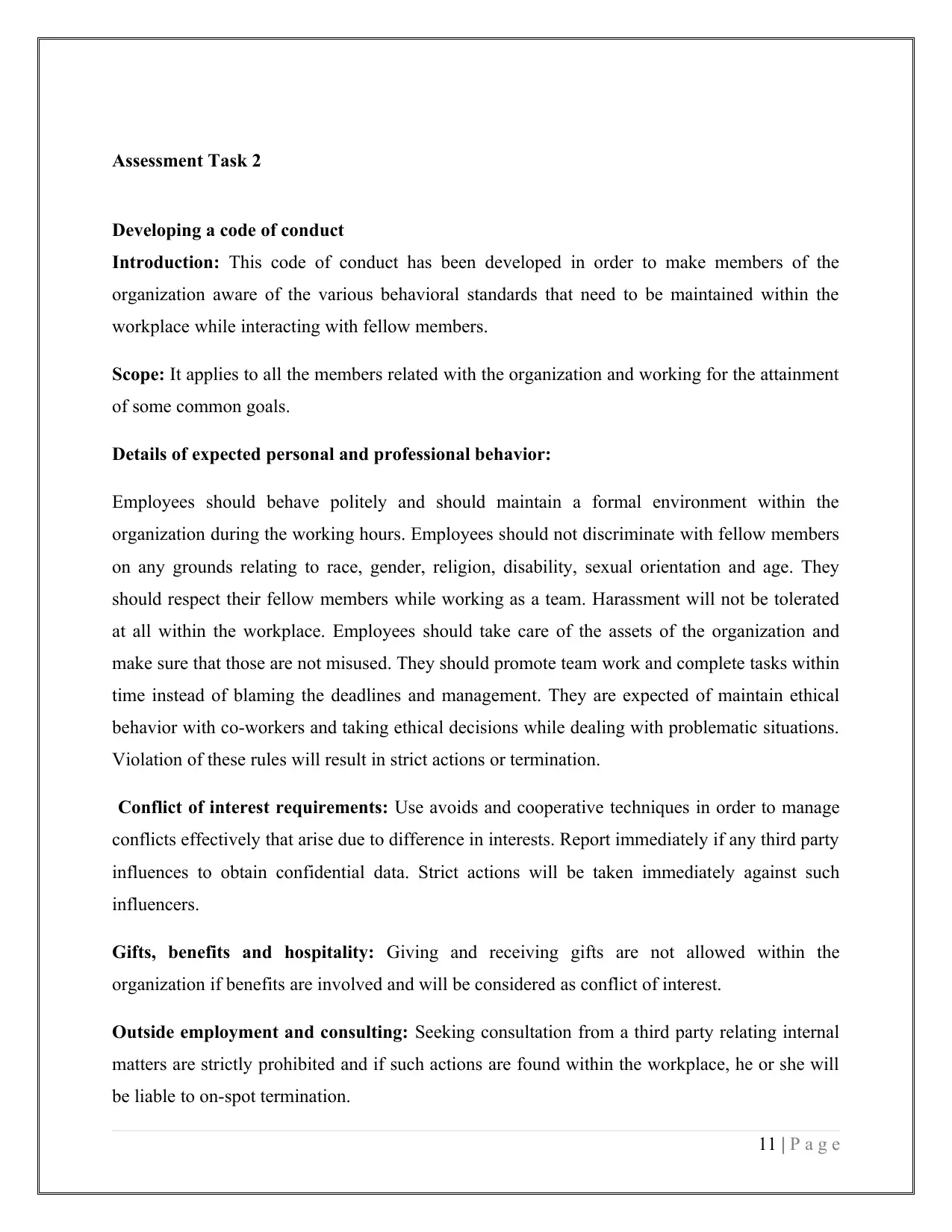
Assessment Task 2
Developing a code of conduct
Introduction: This code of conduct has been developed in order to make members of the
organization aware of the various behavioral standards that need to be maintained within the
workplace while interacting with fellow members.
Scope: It applies to all the members related with the organization and working for the attainment
of some common goals.
Details of expected personal and professional behavior:
Employees should behave politely and should maintain a formal environment within the
organization during the working hours. Employees should not discriminate with fellow members
on any grounds relating to race, gender, religion, disability, sexual orientation and age. They
should respect their fellow members while working as a team. Harassment will not be tolerated
at all within the workplace. Employees should take care of the assets of the organization and
make sure that those are not misused. They should promote team work and complete tasks within
time instead of blaming the deadlines and management. They are expected of maintain ethical
behavior with co-workers and taking ethical decisions while dealing with problematic situations.
Violation of these rules will result in strict actions or termination.
Conflict of interest requirements: Use avoids and cooperative techniques in order to manage
conflicts effectively that arise due to difference in interests. Report immediately if any third party
influences to obtain confidential data. Strict actions will be taken immediately against such
influencers.
Gifts, benefits and hospitality: Giving and receiving gifts are not allowed within the
organization if benefits are involved and will be considered as conflict of interest.
Outside employment and consulting: Seeking consultation from a third party relating internal
matters are strictly prohibited and if such actions are found within the workplace, he or she will
be liable to on-spot termination.
11 | P a g e
Developing a code of conduct
Introduction: This code of conduct has been developed in order to make members of the
organization aware of the various behavioral standards that need to be maintained within the
workplace while interacting with fellow members.
Scope: It applies to all the members related with the organization and working for the attainment
of some common goals.
Details of expected personal and professional behavior:
Employees should behave politely and should maintain a formal environment within the
organization during the working hours. Employees should not discriminate with fellow members
on any grounds relating to race, gender, religion, disability, sexual orientation and age. They
should respect their fellow members while working as a team. Harassment will not be tolerated
at all within the workplace. Employees should take care of the assets of the organization and
make sure that those are not misused. They should promote team work and complete tasks within
time instead of blaming the deadlines and management. They are expected of maintain ethical
behavior with co-workers and taking ethical decisions while dealing with problematic situations.
Violation of these rules will result in strict actions or termination.
Conflict of interest requirements: Use avoids and cooperative techniques in order to manage
conflicts effectively that arise due to difference in interests. Report immediately if any third party
influences to obtain confidential data. Strict actions will be taken immediately against such
influencers.
Gifts, benefits and hospitality: Giving and receiving gifts are not allowed within the
organization if benefits are involved and will be considered as conflict of interest.
Outside employment and consulting: Seeking consultation from a third party relating internal
matters are strictly prohibited and if such actions are found within the workplace, he or she will
be liable to on-spot termination.
11 | P a g e
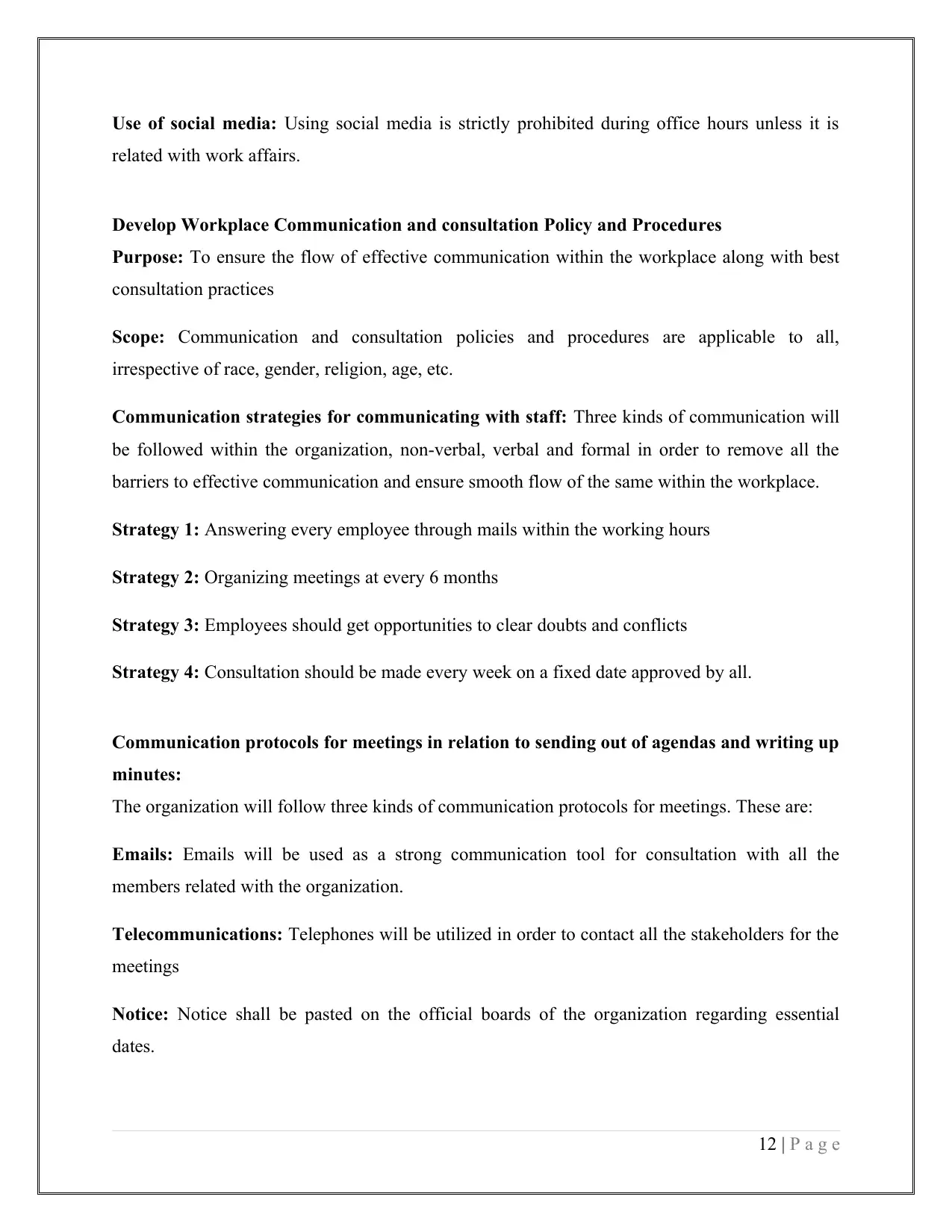
Use of social media: Using social media is strictly prohibited during office hours unless it is
related with work affairs.
Develop Workplace Communication and consultation Policy and Procedures
Purpose: To ensure the flow of effective communication within the workplace along with best
consultation practices
Scope: Communication and consultation policies and procedures are applicable to all,
irrespective of race, gender, religion, age, etc.
Communication strategies for communicating with staff: Three kinds of communication will
be followed within the organization, non-verbal, verbal and formal in order to remove all the
barriers to effective communication and ensure smooth flow of the same within the workplace.
Strategy 1: Answering every employee through mails within the working hours
Strategy 2: Organizing meetings at every 6 months
Strategy 3: Employees should get opportunities to clear doubts and conflicts
Strategy 4: Consultation should be made every week on a fixed date approved by all.
Communication protocols for meetings in relation to sending out of agendas and writing up
minutes:
The organization will follow three kinds of communication protocols for meetings. These are:
Emails: Emails will be used as a strong communication tool for consultation with all the
members related with the organization.
Telecommunications: Telephones will be utilized in order to contact all the stakeholders for the
meetings
Notice: Notice shall be pasted on the official boards of the organization regarding essential
dates.
12 | P a g e
related with work affairs.
Develop Workplace Communication and consultation Policy and Procedures
Purpose: To ensure the flow of effective communication within the workplace along with best
consultation practices
Scope: Communication and consultation policies and procedures are applicable to all,
irrespective of race, gender, religion, age, etc.
Communication strategies for communicating with staff: Three kinds of communication will
be followed within the organization, non-verbal, verbal and formal in order to remove all the
barriers to effective communication and ensure smooth flow of the same within the workplace.
Strategy 1: Answering every employee through mails within the working hours
Strategy 2: Organizing meetings at every 6 months
Strategy 3: Employees should get opportunities to clear doubts and conflicts
Strategy 4: Consultation should be made every week on a fixed date approved by all.
Communication protocols for meetings in relation to sending out of agendas and writing up
minutes:
The organization will follow three kinds of communication protocols for meetings. These are:
Emails: Emails will be used as a strong communication tool for consultation with all the
members related with the organization.
Telecommunications: Telephones will be utilized in order to contact all the stakeholders for the
meetings
Notice: Notice shall be pasted on the official boards of the organization regarding essential
dates.
12 | P a g e
⊘ This is a preview!⊘
Do you want full access?
Subscribe today to unlock all pages.

Trusted by 1+ million students worldwide
1 out of 23
Related Documents
Your All-in-One AI-Powered Toolkit for Academic Success.
+13062052269
info@desklib.com
Available 24*7 on WhatsApp / Email
![[object Object]](/_next/static/media/star-bottom.7253800d.svg)
Unlock your academic potential
Copyright © 2020–2025 A2Z Services. All Rights Reserved. Developed and managed by ZUCOL.





